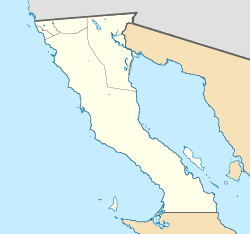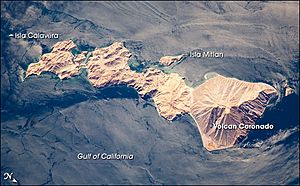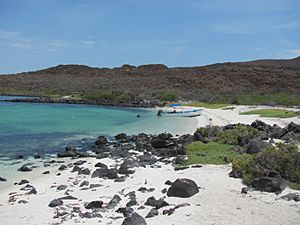Isla Coronado facts for kids
| Geography | |
|---|---|
| Location | Gulf of California |
| Coordinates | 29°04′26.19″N 113°30′31.34″W / 29.0739417°N 113.5087056°W |
| Highest elevation | 431 m (1,414 ft) |
| Administration | |
|
Mexico
|
|
| State | Baja California Sur |
| Demographics | |
| Population | uninhabited |
Isla Coronado, sometimes called “Smith Island”, is a cool island off the coast of Mexico. It's in the Gulf of California, near a place called Bahía de los Ángeles. This island is about 7 kilometers (4.3 miles) long. It has a big volcano at its northern end. Isla Coronado is part of the Ensenada Municipality.
Contents
Island Environment
Isla Coronado has a very dry climate, much like its neighbors Isla Coronadito, Isla Mitlan, and Isla Calavera. This means it doesn't have many plants. Even though it's a tough place to live, many sea lions call the island home! Because fishing and tourism started to affect the islands, local groups created a special plan to protect them in the late 1990s. They even got help from other countries.
The Volcano on Coronado Island
Isla Coronado is home to a volcano also called Coronado (or Volcán Coronado in Spanish). This volcano is about 474 meters (1,554 feet) tall. We don't know exactly when the volcano last erupted. However, people saw gas and steam coming from it in 1539.
Amazing Island Animals
The island is home to seven different kinds of reptiles. These include the Aspidoscelis tigris (tiger whiptail lizard) and the Callisaurus draconoides (zebra-tailed lizard). You might also find the Crotalus mitchellii (speckled rattlesnake) and the Hypsiglena ochrorhyncha (coast night snake). Other reptiles living here are the Phyllodactylus nocticolus (peninsular leaf-toed gecko), the Sauromalus hispidus (spiny chuckwalla), and the Uta stansburiana (common side-blotched lizard).
Underwater World of Isla Coronado
Isla Coronado is very important for the ecology of the Gulf of California. In 1940, a marine biologist named Ed Ricketts and his friend, the author John Steinbeck, went on an adventure here. They explored the rich ocean life in the Gulf of California, also known as the Sea of Cortez. Coronado Island and the Bahía de los Ángeles were key stops on their trip. Their book, The Log from the Sea of Cortez, is still a famous book about the natural history of this area.
Today, Isla Coronado is not inhabited by people. It is a safe place for many kinds of marine animals and plants. It has much more sea life than other parts of the Gulf that are not protected. Most of the island's coast is steep and rocky. But there are also lighter blue lagoons (shallow, calm water areas), especially on the western side. These lagoons are great places for many creatures to live.
Out in the deeper water, currents and waves mix the water. This helps bring important nutrients to the coastal areas. You can sometimes see patterns on the water's surface from sunglint. This is light reflecting off the water towards a camera, like one on the International Space Station. These patterns show how wind and currents make the water rough or smooth.
See also
 In Spanish: Isla Coronado para niños
In Spanish: Isla Coronado para niños





